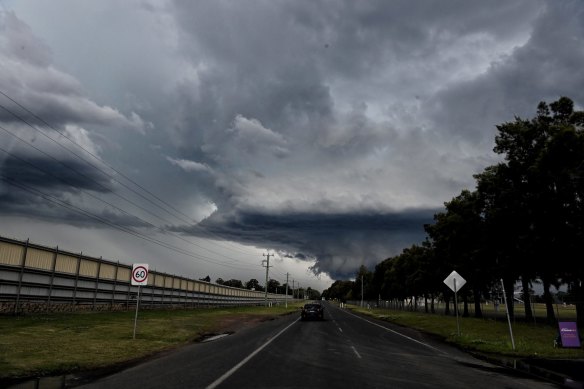This was published 3 years ago
BOM declares La Nina event as east coast braces for rains, floods and cyclones
By Laura Chung and Mike Foley
A sunny summer full of hot days lazing on the beach is far less likely now that a La Nina weather pattern has taken hold over the Pacific Ocean, bringing a stream of wet easterly trade winds to Australia’s eastern seaboard.
The Bureau of Meteorology declared on Tuesday that a La Nina event was in full swing, with climate scientists saying it would bring cooler temperatures, more rainy days and higher risks of extreme weather.

Australia is likely to see heavy rainfall, floods and tropical cyclones this summer with a La Nina event set to be declared on Tuesday.Credit: Nick Moir
“It does mean we get cooler temperatures for Australia, particularly in the eastern and the southern parts,” said bureau manager of climate operations Andrew Watkins. “We’ve got about a 65 per cent chance of seeing more than our average number of 11 cyclones.”
Floods hit Victoria earlier this month when heavy rains lashed Gippsland and around Bendigo, causing rivers to break their banks.
Central NSW has been deluged, and the Lachlan River is flooding towns such as Parkes and Forbes.
More flooding could be on the way in the coming days with 50 to 100 millimetres of rain forecast for parts of Victoria, NSW and Queensland and severe thunderstorms are on the cards.
The bureau’s senior meteorologist, Dean Narramore, said residents on any rivers in NSW and Queensland needed to remain on high alert.
“On Friday, the focus of the rain and thunderstorm activity will move to eastern parts of Queensland, NSW and down into eastern Victoria where we could see, again, widespread heavy rainfall and severe thunderstorms,” he said. “This will, again, exceed the flooding impact increase across eastern parts of Victoria, NSW and Queensland.”
Australia has experienced 18 La Nina events since 1900 and 12 have coincided with flooding in eastern states. The average rainfall from December to March in La Niña years is 20 per cent higher than the long-term average.
During La Nina, the Pacific Ocean cools along the eastern equator near the Americas, coupled with warm waters in the tropics near Australia and south-east to north-westerly winds strengthen, driving clouds westward to Australia’s east coast.
CSIRO research scientist with the Oceans and Atmosphere division James Risbey said it was not possible to say exactly what would play out over summer. While a range of different forecast models are used to predict weather patterns, most show wetter than average conditions persisting over the months ahead, he said.
“It’s quite straightforward to forecast that the event will continue through the summer, and most of the models show [La Nina] continuing through December, January and February and basically breaks down around March,” Dr Risbey said.
However, further complicating the weather drivers at play in the eastern states, Dr Risbey said the recent heavy rains and floods were down to an “unusual” scenario that is not being caused by the La Nina pattern.
A semi-permanent band of low pressure stretching from Antarctica to the southwest corner of the country, known as the West Australian trough, moves westward along the continent’s southern coastline toward Tasmania.
Low-pressure systems typically bring strong winds and rain, but the effect of the West Australian trough on the eastern seaboard is counterbalanced by a semi-permanent cell of high pressure in the Tasman Sea near Tasmania, which guides the low-pressure system towards the Antarctica.
But the normally reliable high-pressure cell in the Tasman Sea has broken down.
“That means these [wet low pressure] systems are free to flow on and just bubble across the Australian continent, rather than being steered south of the continent as they go across,” Dr Risbey said.
Dr Watkins said while La Nina events typically delivered cooler than average temperatures, it was still possible to get heatwaves over summer - which tend to be more humid than normal due to the amount of moisture in the landscape.
University of NSW’s Climate Change Research Centre Associate Professor Andréa Taschetto said as climate change continues to alter the landscape, extreme La Nina and El Nino events are likely to become more common.
“In the future, we have more chances of storms, extreme rainfall and flood events,” she said. “It’s happening. We know global warming increases the chance of extreme events: bushfires, temperatures and droughts.”
A guide to the environment, what’s happening to it, what’s being done about it and what it means for the future. Sign up to our fortnightly Clear Air newsletter here.